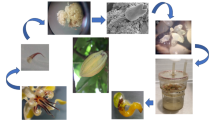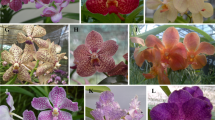Abstract
This study described a protocol for genetically stable synseed production of Azadirachta indica using shoot tips of in vitro grown plantlets. For this, the shoot tips from in vivo grown tree were cultured on Murashige and Skoog (MS) media. The highest shoot response, number of buds per shoot and longest shoot were 94.44%, 5.07 and 3.73 cm, respectively, with 0.5 mg L−1 benzyladenine (BA) and 0.1 mg L−1 α-naphthaleneacetic acid in combination. These shoots were further enhanced by subculturing and the second subculture yielded both maximum shoots per micro shoot (6.08) and longer shoot length (4.64 cm) on the same media composition. The shoot tips of this subculture were employed for encapsulation. The 3% sodium alginate and 75 mM calcium chloride with an anion exchange period of 20 min was found to be best for synseed production which displayed a quick response (3.17 days) for germination with 100% germination frequency. The maximum in vitro root response, the highest number of roots per shoot and longest root length were 91.67%, 4.78 and 3.18 cm, respectively, in 1/2 strength MS media with 0.5 mg L−1 indole-3-butyric acid and 0.1 mg L−1 BA in combination. The 24 °C stored synseeds showed more germination frequency and regeneration potentiality in all storage periods as compared to 4 °C stored synseeds. The soil: organic manure (1:1) exhibited the best result of plant survival (91.18%) for primary hardening after 1 month and it displayed 85.9% after two months in the vermiculite-soil mixture (2:1) after secondary hardening. This investigation certified the genetic fidelity of synseed-derived plantlets after storage at 4 °C and 24 °C using ISSR markers. None of the ISSR markers exposed polymorphism for hardened plants.
Key message
This study reported first time the development of synseed of neem. The genetic fidelity of regenerants were performed after storage at 4°C and 24°C for different period of times (Days) using ISSR markers.



Similar content being viewed by others
References
Ahmad N, Anis M (2010) Direct plant regeneration from encapsulated nodal segments of Vitex negundo. Biol Plant 54(4):748–752. https://doi.org/10.1007/s10535-010-0134-8
Akula C, Akula A, Drew D (2003) Somatic embryogenesis in clonal neem, Azadirachta indica A. Juss. and analysis for in vitro azadirachtin production. In Vitro Cell Dev Biol-Plant 39:304–310. https://doi.org/10.1079/IVP2003415
Allan EJ, Stuchbury T, Mordue AJ (1999) Azadirachta indica A juss. (Neem tree): in vitro culture, micropropagation, and the production of Azadirachtin and other secondary metabolites. In: Bajaj YPS (ed) Biotechnology in agriculture and forestry, 43. Medicinal and aromatic plants XI. Springer-Verlag, Berlin, pp 11–41
Arora K, Sharma M, Srivastava J, Ranade SA, Sharma AK (2010) Rapid in vitro cloning of a 40-year-old tree of Azadirachta indica A. Juss. (Neem) employing nodal stem segments. Agroforest Syst 78(1):53–63. https://doi.org/10.1007/s10457-009-9230-1
Bekheet SA, Taha HS, Saker MM, Solliman ME (2007) Application of cryopreservation technique for in vitro grown date palm (Phoenix dactylifera L.) cultures. J Appl Sci Res 3(9):859–866
Bordallo PN, Silva DH, Maria J, Cruz CD, Fontes EP (2004) Somaclonal variation on in vitro callus culture potato cultivars. Hortic Bras 22(2):300–304. https://doi.org/10.1590/S0102-05362004000200027
Cassels AC, Curry RF (2001) Oxidative stress and physiological, epigenetic and genetic variability in plant tissue culture: implications for micropropagators and genetic engineers. Plant Cell Tissue Organ Cult 64(2–3):145–157. https://doi.org/10.1023/A:1010692104861
Cecchini E, Natah L, Cavallini A, Durante M (1992) DNA variation in regenerated plants of pea (Pisum sativum L.). Theor Appl Genet 84(7–8):874–879. https://doi.org/10.1007/BF00227399
Cheruvathur MK, Najeeb N, Thomas TD (2013) In vitro propagation and conservation of Indian sarsaparilla, Hemidesmus indicus L. R. Br. through somatic embryogenesis and synthetic seed production. Acta Physiol Plant 35(3):771–779. https://doi.org/10.1007/s11738-012-1117-5
Danso KE, Ford-Lloyd BV (2003) Encapsulation of nodal cuttings and shoot tips for storage and exchange of cassava germplasm. Plant Cell Rep 21(8):718–725. https://doi.org/10.1007/s00299-003-0594-9
Divakaran M, Babu KN, Peter KV (2006) Conservation of Vanilla species, in vitro. Sci Hortic 110(2):175–180. https://doi.org/10.1016/j.scienta.2006.07.003
Einset JW (1986) Cytokinin consumption by micropropagated shoots. Proc Int Plant Prop Soc 36:635–640
Faisal M, Alatar AA, Ahmad N, Anis M, Hegazy AK (2012) Assessment of genetic fidelity in Rauvolfia serpentina plantlets grown from synthetic (encapsulated) seeds following in vitro storage at 4 °C. Molecules 17(5):5050–5061. https://doi.org/10.3390/molecules17055050
Faisal M, Alatar AA, Hegazy AK (2013) Molecular and biochemical characterization in Rauvolfia tetraphylla plantlets grown from synthetic seeds following in vitro cold storage. Appl Biochem Biotechnol 169(2):408–417. https://doi.org/10.1007/s12010-012-9977-0
Gehlot A, Arya ID, Kataria V, Gupta RK, Arya S (2014) Clonal multiplication of multipurpose desert tree Azadirachta indica - Neem. J Arid Land Stud 24(1):37–40
Gehlot A, Arya ID, Arya S (2017) Regeneration of complete plantlets from callus culture of Azadirachta indica A. Juss using immature flower buds. Adv for Sci 4(1):71–76
Geng F, Moran R, Day M, Halteman W, Zhang D (2016) Increasing in vitro shoot elongation and proliferation of ‘G.30’ and ‘G.41’ Apple by chilling explants and plant growth regulators. Hort Sci 51(7):899–904. https://doi.org/10.21273/HORTSCI.51.7.899
Ghosh PD, Chattopadhyay SK, Adhikari S, Saha S, Mondal S, Kader A, Dey ST, Bandyopadhyay TK, Sengupta C (2013) A high throughput DNA extraction method from chemotypically heterogeneous plant species. Protocol Exchange. https://doi.org/10.1038/protex.2013.018
Haque E, Mandal I, Pal S, Baral R (2006) Prophylactic dose of neem (Azadirachta indica) leaf preparation restricting murine tumor growth is nontoxic, hematostimulatory and immunostimulatory. Immunopharmacol Immunotoxicol 28:33–50. https://doi.org/10.1080/08923970600623632
Harding K (2004) Genetic integrity of cryopreserved plant cells: a review. Cryo Lett 25(1):3–22
Ibáñez A, Valero M, Morte A (2003) Influence of cytokinins and subculturing on proliferation capacity of single-axillary-bud microcuttings of Vitis vinifera L. cv. Napoleón Anales De Biología 25:81–90
Jin S, Mushke R, Huaguo Z, Tu L, Lin Z, Zhang Y, Zhang X (2008) Detection of somaclonal variation of cotton (Gossypium hirsutum) using cytogenetics, flow cytometry and molecular markers. Plant Cell Rep 27(8):1303–1316. https://doi.org/10.1007/s00299-008-0557-2
Kader A, Sinha SN, Ghosh P (2022) Callus formation and regeneration tendency of Justicia vasica nees under saline conditions. Curr Appl Sci Technol. https://doi.org/10.55003/cast.2022.01.22.007
Kamińska M, Gołębiewski M, Tretyn A, Trejgell A (2018) Efficient long-term conservation of Taraxacum pieninicum synthetic seeds in slow growth conditions. Plant Cell, Tissue Organ Cult 132(3):469–478. https://doi.org/10.1007/s11240-017-1343-z
Karpinski S, Wingsle G, Karpinska B, Hallgren JE (2002) Low-temperature stress and antioxidant defense mechanism in higher plants. In: Inze D, van Montagu M (eds) Oxidative stress in plants. Taylor and Francis Publishers, London, pp 69–103
Khan N, Ahmed M, Hafiz I, Abbasi N, Ejaz S, Anjum M (2015) Optimizing the concentrations of plant growth regulators for in vitro shoot cultures, callus induction and shoot regeneration from calluses of grapes. J Int Sci Vigne Du Vin 49(1):37–45. https://doi.org/10.20870/oeno-one.2015.49.1.95
Konan NK, Schopke C, Beachy RN, Faquet C (1997) An efficient mass propagation system for Cassava (Manihot esculenta Crantz) based on nodal explants and axillary bud-derived meristems. Plant Cell Rep 16(7):444–449. https://doi.org/10.1007/BF01092763
Kumar D, Mishra DK (2014) Variability in permeability and integrity of cell membrane and depletion of food reserves in neem (Azadirachta indica) seeds from trees of different age classes. J for Res 25(1):147–153. https://doi.org/10.1007/s11676-014-0440-7
Lata H, Chandra S, Techen N, Khan IA, ElSohly MA (2011) Molecular analysis of genetic fidelity in Cannabis sativa L. plants grown from synthetic (encapsulated) seeds following in vitro storage. Biotechnol Lett 33(12):2503–2508. https://doi.org/10.1007/s10529-011-0712-7
Lyons JM (1973) Chilling injury in plants. Annu Rev Plant Physiol 24(1):445–466
Mehrotra S, Khwaja O, Kukreja AK, Rahman L (2012) ISSR and RAPD based evaluation of genetic stability of encapsulated micro shoots of Glycyrrhiza glabra following 6 months of storage. Mol Biotechnol 52(3):262–268. https://doi.org/10.1007/s12033-011-9491-6
Murashige T, Skoog F (1962) A revised medium for rapid growth and bioassays with tobacco tissue culture. Physiol Plant 15(3):473–497. https://doi.org/10.1111/j.1399-3054.1962.tb08052.x
Nor Asmah H, Nor Hasnida H, Nashatul Zaimah NA, Noraliza A, Nadiah Salmi N (2011) Synthetic seed technology for encapsulation and regrowth of in vitro-derived Acacia hyrid shoot and axillary buds. Afr J Biotechnol 10(40):7820–7824. https://doi.org/10.5897/AJB11.492
Padilla IMG, Barba-Espín G, Hernández JA, Piqueras A, Burgos L (2021) Acetylsalicylic acid improved antioxidative status and cold storage of encapsulated nodal segments of neem (Azadirachta indica A. Juss). Plant Cell, Tissue Organ Cult 144(4):261–270. https://doi.org/10.1007/s11240-020-01828-z
Quraishi A, Koche V, Sharma P, Mishra SK (2004) In vitro clonal propagation of neem (Azadirachta indica). Plant Cell, Tissue Organ Cult 78(3):281–284. https://doi.org/10.1023/B:TICU.0000025647.58548.3d
Rani V, Raina SN (1998) Genetic analysis of enhanced axillary branching derived Eucalyptus tereticornis Smith and E. camaldulensis Dehn plants. Plant Cell Rep 17(3):236–242. https://doi.org/10.1007/s002990050385
Rizvi MZ, Kukreja AK, Bisht NS (2012) Plant regeneration in Chlorophytum borivilianum Sant. et Fernand. from embryogenic callus and cell suspension culture and assessment of genetic fidelity of plants derived through somatic embryogenesis. Physiol Mol Biol Plants 18(3):253–263
Rohela GK, Jogam P, Shabnam AA, Shukla P, Abbagani A, Ghosh MK (2018) In vitro regeneration and assessment of genetic fidelity of acclimated plantlets by using ISSR markers in PPR-1 (Morus sp.): An economically important plant. Sci Hortic 241:313–321. https://doi.org/10.1016/j.scienta.2018.07.012
Rout GR, Senapati SK, Aparajita S, Palai SK (2009) Studies on genetic identification and genetic fidelity of cultivated banana using ISSR markers. Plant Omics 2(6):250–258
Salvi ND, Singh H, Tivarekar S, Eapen S (2001) Plant regeneration from different explants of neem. Plant Cell, Tissue Organ Cult 65(2):159–162. https://doi.org/10.1023/A:1010672809141
Shahin-uz-zaman M, Ashrafuzzaman M, Haque MS, Luna LN (2008) In vitro clonal propagation of the neem tree (Azadirachta indica A. Juss). Afr J Biotechnol 7(4):386–391
Silvestroni O (1981) Prime esperienze sulla micropropagazione della vite europea. Vignevini 8(10):31–37
Singh AK, Sharma M, Varshney R, Agarwal SS, Bansal KC (2006) Plant regeneration from alginate-encapsulated shoot tips of Phyllanthus amarus Schum and Thonn, a medicinally important plant species. In Vitro Cell Dev Biol Plant 42:109–113. https://doi.org/10.1079/IVP2005735
Siwach P, Gill AR (2011) Enhanced shoot multiplication in Ficus religiosa L. in the presence of adenine sulphate, glutamine and phloroglucinol. Physiol Mol Biol Plants 17(3):271–280. https://doi.org/10.1007/s12298-011-0074-6
Srinidhi HV, Gill RIS, Sidhu DS (2008) Micropropagation of adult and juvenile Neem (Azadirachta indica A. Juss). J Crop Improv 21(2):221–232. https://doi.org/10.1080/15427520701885790
Stanišić M, Raspor M, Ninković S, Milošević S, Ćalić D, Bohanec B, Trifunović M, Petrić M, Subotić A, Jevremović S (2015) Clonal fidelity of Iris sibirica plants regenerated by somatic embryogenesis and organogenesis in leaf-base culture - RAPD and flow cytometer analyses. S Afr J Bot 96:42–52. https://doi.org/10.1016/j.sajb.2014.10.014
Tabassum B, Nasir IA, Farooq AM, Rehman Z, Latif Z, Husnain T (2010) Viability assessment of in vitro produced synthetic seeds of cucumber. Afr J Biotechnol 9(42):7026–7032. https://doi.org/10.5897/AJB10.060
Torregrosa L, Bouquet A (1995) In vitro propagation of Vitis x Muscadinia hybrids by microcuttings or axillary budding. Vitis 34(4):237–238
Tsvetkov I, Jouve L, Hausman JF (2006) Effect of alginate matrix composition on regrowth of in vitro-derived encapsulated apical micro cuttings of hybrid aspen. Biol Plant 50(4):722–724. https://doi.org/10.1007/s10535-006-0115-0
You J, Chan Z (2015) ROS regulation during abiotic stress responses in crop plants. Front Plant Sci 6:1092. https://doi.org/10.3389/fpls.2015.01092
Acknowledgements
The authors are thankful to the head of the department of Botany, the University of Kalyani for providing DST-FIST central equipment facility.
Funding
The authors declare that no funds, grants, or other support were received during performing the experiments and the preparation of this manuscript.
Author information
Authors and Affiliations
Contributions
AK performed the research and wrote the manuscript. PG provided the laboratory and SNS analyzed the data.
Corresponding author
Ethics declarations
Conflict of interest
The author declares that they have no conflict of interest.
Additional information
Communicated by Ranjith Pathirana.
Publisher's Note
Springer Nature remains neutral with regard to jurisdictional claims in published maps and institutional affiliations.
Rights and permissions
About this article
Cite this article
Kader, A., Sinha, S.N. & Ghosh, P. A strategy for development of genetically stable synseeds of Azadirachta indica A. Juss. (Neem) suitable for in vitro storage . Plant Cell Tiss Organ Cult 151, 47–58 (2022). https://doi.org/10.1007/s11240-022-02329-x
Received:
Accepted:
Published:
Issue Date:
DOI: https://doi.org/10.1007/s11240-022-02329-x




